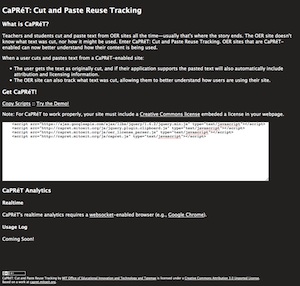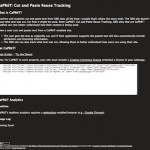CaPRéT Final Report
Here’s the “final” report for the CaPRéT work with JISC CETIS funding.
I say “final”, even though we still need to finish off the simple tabular display (and .csv export) for basic analytics.
We showed off CaPRéT at OpenEd 2011 and have been invited by Cable Green at Creative Commons to use the work we’ve done with CaPRéT as the basis for analytics for Creative Commons licenses. Some, pretty heady stuff. We’re still working through this with Cable and Creative Commons, we’ll report back to JISC CETIS and oer-discuss as we make progress.
Recap
What is CaPRéT?
[fusion_builder_container hundred_percent=”yes” overflow=”visible”][fusion_builder_row][fusion_builder_column type=”1_1″ background_position=”left top” background_color=”” border_size=”” border_color=”” border_style=”solid” spacing=”yes” background_image=”” background_repeat=”no-repeat” padding=”” margin_top=”0px” margin_bottom=”0px” class=”” id=”” animation_type=”” animation_speed=”0.3″ animation_direction=”left” hide_on_mobile=”no” center_content=”no” min_height=”none”]
Teachers and students cut and paste text from OER sites all the time–usually that’s where the story ends. The OER site doesn’t know what text was cut, nor how it might be used. Enter CaPRéT–Cut and Paste Reuse Tracking. OER sites that are CaPRéT-enabled can now better understand how their content is being used.When a user cuts and pastes text from a CaPRéT-enabled site:
- The user gets the text as originally cut, and if their application supports it the pasted text will also automatically include attribution and licensing information.
- The OER site can also track what text was cut, allowing them to better understand how users are using their site.
How does it work?
CaPRéT uses the jQuery library and a jQuery clipboard extension to monitor the copy event on a given web page. At the time content is copied, the extension adds attribution information that was parsed from the page using a OER license parser (thanks to Pat Locksley’s OpenAttribute for Chrome project). In addition, analytics are gathered at the moment content is copied so that even if the user chooses to remove the attribution information, the server still gathers information that indicates the content was used. If the user pastes the code into another webpage (and does not remove the attribution information) then a small tracking code is included which records views of the copied content. There are also some nifty analytics that display what’s happening in real-time, and basic analytics that displays what’s been cut.
Try it for yourself!
The CaPRéT demo site is at capret.mitoeit.org. And the source code can be downloaded from Github https://github.com/tatemae/capret.
Impact
JISC CETIS provided a great opportunity to work on a small project with both immediate and far reaching implications. Some of the impacts are:
- CaPRéT has produced a tool that can jumpstart the efforts of OER providers to better understand the use of their materials. It is a great example of the type of thing all OER providers should be doing to go beyond what traditional web analytics shows about use. If one of the goals of OER is to share materials so they are used and reused broadly, then the community needs tools to demonstrate that use. Visiting a web page is a start (and where most analytics ends). But what happens after that is, in our opinion, where things really get interesting. CaPRéT addresses one of those use cases (cut-and-paste). There are others that could build upon the notion of tracking–for example, embeding “phone home” features in a downloaded OER that pings back when a downloaded OER is viewed/used by a user.
- OER Glue will be able to take advantage of the tracking capabilities right away. For materials that have properly embeded license information, OER Glue can now parse that information and save it in relation to the resource.
- We’re in discussions with Creative Commons to take the basics of the analytics and process we developed for CaPRéT and use it as the starting point for analytics for Creative Commons licenses. Not unsurprisingly, the basic idea behind CaPRéT, that providers of materials should be able to better understand how those materials are used and where they are reused, is a widespread need.
- This has been a fun project that has focused our discussions and collaborations with the the OER community in the UK. On a practical level, the funding has helped to link together the work being done in the UK with that being done elsewhere.
Stuff We’re Still Working On
Here’s a list of what we’re still actively working on:
- Tabular display of copy and paste analytics (and .csv export).
- That entire integrate / use as the basis for Creative Commons license analytics thing…
- Integrate CaPRéT with the mirror of MIT OpenCourseWare that we are running as part of Project Greenfield. Believe it or not I’ve been working on downloading the mirror, off and on, when I get the chance to plug in to a wired network connection, for about two weeks now. So far it’s 165GB including the videos, and I now need to find a server here to host *that* much data from. If you’re interested, our previous copy, without videos, was in the 40GB range.
Future Work
Here’s a list of what we hope to do in future work:
- Add a
prefs.jsaspect to the feature set. So as a site that implements CaPRéT, you can choose:- Whether you want to display the license and citations (yes that is part of the point of the service, but it can also muck up the display and annoy your users), and perhaps whether you’d like a static default for both.
- Whether you want to include the tracking .gif (there are some reasonable privacy concerns with this one, the ability to complete the loop on use can be useful, but it should be done with full warning users of the sites implementing CaPRéT).
- Look for more adopters.
[/fusion_builder_column][/fusion_builder_row][/fusion_builder_container]





Got this note from Guy Barrett at the Open University.
“Hi Brandon, hope all is well, I though it worth mentioning that Openlearn is now using a simplified approach to CaPRéT, by just tracking the copy events and not injecting paste texts. They see this as less intrusive and useful from an analysis perspective. So now just CRéT!”